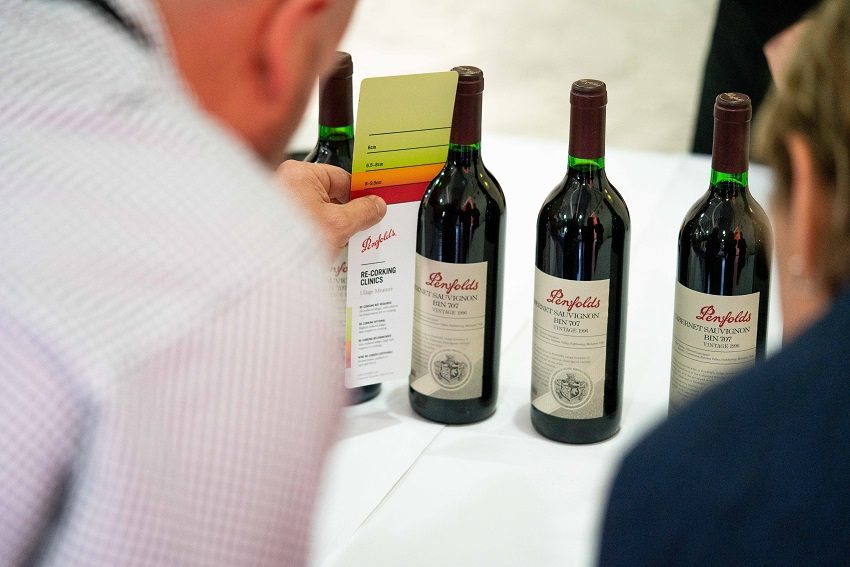Inside Penfolds' clinic for testing the health of your Grange

Unique in the wine world, Penfolds Red Wine Re-Corking Clinics allow owners of Penfolds’ hallowed drop to get their bottles of Grange assessed by experts.
In Robert Louis Stevenson’s Treasure lsland, the ritual of being handed the Black Spot spells incipient doom; at a Penfolds Red Wine Re-corking Clinic, the dreaded signifier is a white dot, affixed by the assessing winemakers to a bottle that hasn’t made the grade.
Penfolds has been holding its red wine clinics for 27 years, and in terms of after-sales service there is still nothing else in the wine world quite like them. Mounted at the company’s expense, the clinics allow owners of Grange and other Penfolds reds more than 15 years old to bring in their wines for a one-off, expert assessment. Wines found to be “good” are topped up with the current release of Grange, re-corked with a new, top-grade, dated cork, given a fresh capsule and certified with a signed sticker. The clinics are held annually in most Australian capitals, and are also run periodically in other parts of the world where clusters of top-end Penfolds owners can be found, including Hong Kong, Singapore, Auckland, London, New York and Chicago.

The Adelaide version is held over three days in an airy stone building in the Penfolds complex at Magill, only a couple of hundred metres up the hill from the original Grange cottage built in 1844 for Dr Christopher Penfold and his wife Mary.
Owners of aged Penfolds reds book a time slot to have their wines assessed by the company winemakers. Most bring in one, two or three bottles, but it isn’t unknown for people to bring in several cases. It’s hard to profile a typical punter: “We get everyone from billionaires to mums and dads,” Peter Gago says. And he means it literally – it has been known for younger Grange owners to unload their bottles from the back-pocket flap of a pram or stroller.
As chief winemaker at Penfolds, Gago is the current “custodian” of Grange, the latest incumbent in a line that reaches back to Max Schubert, who conceived and developed Grange Hermitage in the early 1950s (the “Hermitage” was dropped two decades ago, in deference to the French). Some of the bottles that come in for testing are wines made by Schubert, including examples of the so-called hidden Granges, the three vintages he made on the quiet against the company’s will. While part of the Grange legend rests on its capacity for longevity, the drinkability of any wine made more than 40 – or 15 – years ago can’t be assumed.

Gago estimates the overall attrition rate at the clinics at around 10 per cent, although the incidence of “off” or “gone” bottles obviously climbs as the vintage year recedes. While the winemakers do pour a tiny sample to assess the soundness and condition of each wine by its colour and smell, there are other clues, including the condition of the cork. And if the level of wine has fallen below the shoulder of the bottle, it is automatically failed.
Many owners inadvertently bring about the demise of their own wines by failing to cellar them properly, Gago says: keeping the bottles horizontal, still and cool is paramount.
Gago and his offsiders regularly have to break the bad news to people whose treasured bottles haven’t passed the test of time, applying the dreaded white dot and thereby devaluing them instantaneously from hundreds or thousands of dollars to virtually worthless. Reactions vary, Gago says: most people are stoic, some are visibly crestfallen, while others seem completely blithe.
Suspense is generally avoided – Gago tells the story of an elderly woman who brought in what she thought was a bottle of 1953 Grange. When informed it wasn’t actually a Grange, the colour drained from her face, and Gago had to tell her hastily that it was something even better – a very rare example of the straight Cabernet made by Max Schubert in the same year, employing the Grange technique.

While Penfolds is perfectly well aware of the eye-watering dollar value conferred on old Granges and Special Bin reds by the secondary market (it’s no accident that the clinics’ function of weeding out the duds contributes significantly to the market’s integrity), the accent on the day is very much on aged red wine in its role as a drinkable, sensory pleasure. Wine auctioneers Langton’s do attend the Adelaide clinic, but are kept at arm’s length in a separate outbuilding where the investment-minded can take their newly certified bottles to discuss the sordid matter of monetary value if they so wish.
Inevitably, Gago says, the most sought-after piece of advice is about when an individual wine should be drunk. Many, he says, tend to hold off too long. “Everywhere we go around the world people say the same two things: ‘I could afford to buy it, but I can’t afford to drink it’ and ‘I’m waiting for a special occasion to open it’.”
Gago says his almost invariable advice is to encourage people to drink and enjoy their precious possessions sooner rather than later. “Otherwise,” he tells them, “your children will be drinking it at your wake without you.”